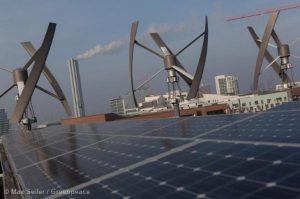Colombia has submitted its national climate plan to 2030 to the UN, its contribution to the new global climate agreement to be signed in Paris later this year. After Mexico and the Dominican Republic, the plan is the third published in Spanish-speaking Latin America and the Caribbean and the fourth from the region following Trinidad and Tobago’s submission over a month ago. The Colombian contribution seeks a stronger balance between its mitigation target and the plans to build a climate resilient country and it consolidates several existing policies on mitigation and adaptation.
Colombia’s climate plan to 2030 (also known as intended nationally determined contribution, or INDC) includes an unconditional target which pledges to reduce its greenhouse gas emissions (GHGs) by 20% with respect to Business-as-Usual (BAU) levels – the economy-wide target that covers 100% of national emissions, according its 2010 National Greenhouse Gas Inventory. It includes the six GHGs recognised by the Kyoto protocol: CO2, CH4, N2O, HFCs, PFCs, SF6 and covers all emissions sectors acknowledged by the Intergovernmental Panel on Climate Change. Based on the outcome of the climate negotiations in Paris in the COP 21, Colombia will consider communicating an indicative target for 2025, consistent with its 2030 target.
The conditional target would increase its ambition from 20% to 30% with respect to BAU by 2030, subject to international support through climate finance or carbon markets.
The adaptation component is based on the country’s National Adaptation Plan to Climate Change (PNACC in Spanish) from 2011 which includes plans for specific regions. Colombia has formulated 11 territorial climate adaptation plans and the PNACC identifies vulnerable areas within a territory and outlines the measures needed to reduce their vulnerability to climate change. There are also innovative sectoral adaptation plans – which address agriculture and the road network. In total, Colombia has identified six priority sectors of the economy; transport, energy, agriculture, housing, health, and trade, tourism and industry.
Colombia’s adaptation and resilience efforts to 2030 will also take into account other global targets set out by agreements such as the Convention on Biological Diversity (CBD), the 2030 Development Agenda, the UN Convention to Combat Desertification (UNCCD) and the Sendai Framework for Disaster Risk Reduction 2015-2030.
The specifics are described in the UNFCCC document which lists over a dozen actions such as the development of the “National System of Adaptation Indicators” to support monitoring and evaluation of adaptation measures.
The Government considers its target to be fair and equitable. The discussion of equity centres on reaching the target of per capita emissions levels of 4.6 tonnes of CO2 equivalent by 2030. According to the government, this would be even lower than the country’s per capita emissions in 2010 (when it was 4.8 tonnes of CO2 equivalent). The business as usual scenario suggests that emissions per capita would have been 5.8 tonnes in 2030. The document also highlights Colombia’s middle-income status and qualitative elements such as its high vulnerability to climate change, the need to build and sustain peace and how building resilience contributes to this goal and to combating poverty.
Many analysts, especially in Europe and the US, will focus attention on the 20% target in Colombia’s INDC and the country will be judged according to it.
We need to complement carbon-centric assessments with broader debates about development choices and the INDC could ignite this debate in Colombia. The contribution for Paris will need to come from both inside and, more importantly, outside the government. Moreover, making progress on this first mitigation target could create space to have a more complex debate around energy sources, around which there are pertinent questions: What will be the role of coal in the Colombian economy moving towards 2030 and 2050? Will there be a route to invest more private and public capital in renewable energy?
Having a third INDC from Latin America and the Caribbean is a highly positive development for the region. Colombia is becoming a positive reference on matters related to climate policy and it plays a very active role in the UN climate negotiations. This INDC provides a concrete opportunity to increase clarity and transparency on its’ climate policy orientation and to integrate different components that are often disconnected.
The deliberate integration of the mitigation and adaptation components will be critical not only to Colombia but also to the entire Latin America region because our cities, natural capital and people are so highly vulnerable to climate change. Resilience is looming as a new priority and this could bring the region together, despite deep differences on other issues.
Colombia has developed very specific plans for mitigation and will no doubt be a pioneer in building resilience while seeking to grow along low carbon pathways. Its decentralised approach will deliver very valuable lessons beyond Colombia. Furthermore, the integration of a green growth strategy within the Colombian planning process has no precedents in our region – a new step in the right direction in that it broadens the mandate for cleaner growth beyond environmental governance and makes it part of long-term economic planning.
This article was first published by Nivela.org. To view the original article click here





